By Mike Tanner, Photos By John Stackpole
COROLLA, NC -- Turning off Highway 12 in the far northern reaches of North Carolina's Outer Banks, you get the idea that The Currituck Club isn't your typical pancake flat coastal golf course.
The handsome beige clubhouse, highlighted by a stone foundation and white-painted window trim and columns, presides over the club's entrance from the summit of a sandy ridge of impressive dimensions.
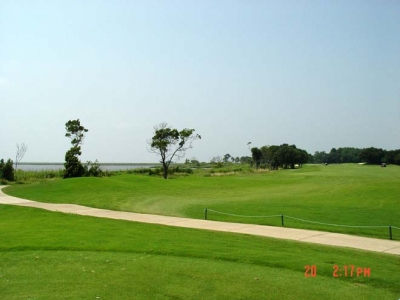 |
| View of Currituck Sound from the tee on the 7th hole. |
Towering sand dunes are just the beginning at this Rees Jones-designed layout. The 6,885-yard course also features pockets of maritime forest, marsh grass-filled wetlands and a lengthy stretch of shoreline along the Currituck Sound. This diverse landscape so impressed Jones that he disturbed it as little as possible.
"Reese didn't move a lot of dirt here," said Director of Golf Craig Menne. "He left the natural contours pretty much as he found them. The elevation changes are exceptional for a coastal golf course."
Jones's work at The Currituck Club attracted attention from the golf industry immediately after opening in 1996. GOLF Magazine named it one of its Top Ten New Courses to Play that year. Just three years later, in 1999, the rapidly maturing course appeared in Golf Digest's list of Top 25 Courses in North Carolina.
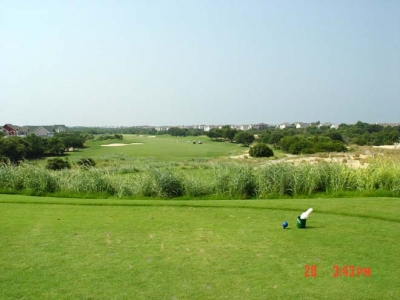 |
| Enjoy the view from the tee of the par five 13th hole. |
Readers familiar with his design philosophy will happily recognize several distinctive Rees Jones characteristics at The Currituck Club. Each hole is clearly defined with unobstructed sight lines to target areas. Mounding along the Bermudagrass fairways helps keep moderately mis-hit tee shots in play. The generously sized bentgrass greens are accessible through the air, and in most cases, along the ground.
In short, the course has an open feel, with subtle elements that are revealed each time you return. Those nuances and the famously capricious Outer Banks wind make every round a little different. The Currituck Club is composed of two loops -- clockwise on the front nine and counterclockwise on the back -- so you encounter headwinds and tailwinds on each side.
The first hole introduces the course with a 541-yard, par-5 that features a tee shot from the top of the same massive sand dune occupied by the clubhouse. It's a straightaway hole with a single fairway bunker on the left, mostly for aiming purposes, and plenty of room to land your drive. The green is protected by a bunker on the left front and a pond to the right, but there is an opening for bold players to bid for an eagle with a perfectly struck second shot that runs up between the hazards.
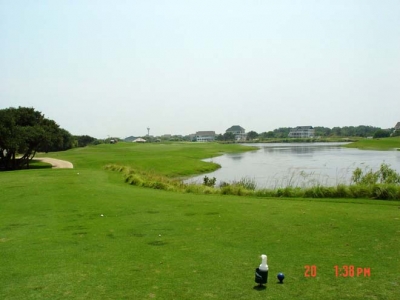 |
| Slicers beware on the par four 4th hole. |
The midpoint of the front nine features a rare conjunction at The Currituck Club. As Craig Menne explained, "The pond around holes 4, 5, and 6 is one of the prettiest spots because you can see a lot of the course there." In fact, from the fourth tee, you can look back to the third green and ahead to all of the next three holes. It's the only time during your round that you'll see more than one or two holes at a time.
The aforementioned pond lies between the fourth and fifth holes, parallel par-4s with water on the right from tee to green. That could be double trouble for players who leak their tee shots, while players who draw the ball benefit from grassy mounds that tend to catch errant shots or even kick them back into the fairway.
At the par-3 sixth hole, which demands a 200-yard carry over the pond from the back tees to the safety of the putting surface, you catch your first glimpse of the Currituck Sound.
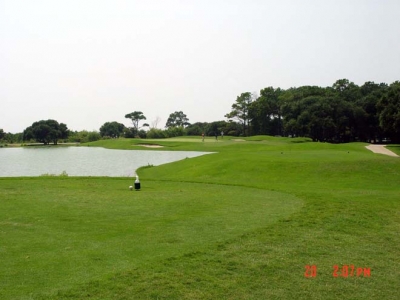 |
| Better long than short on the par three 6th hole. |
A slight digression here: There is a 15-acre preserve (unfortunately hidden from view) at this end of The Currituck Club property. It's the site of one of the grand hunt clubs built in the mid-1800s by northern industrial magnates who traveled by train and boat to this remote location for the purpose of hunting the abundant waterfowl of the day. The Currituck Shooting Club was originally built in 1857 and rebuilt in 1879. The present cedar shake-shingled clubhouse and outbuildings are listed on the National Register of Historic Places.
Standing on the seventh tee, you command a sweeping view of the Currituck Sound and the comparatively narrow fairway of this 532-yard hole. Don't let the scenery distract you from the task at hand because this is the second-most difficult hole on the course.
The eighth hole is a sturdy 432-yard, par-4 with the teeing area set off at angle that creates a dogleg to the left. The ninth hole is a modest 356-yard two-shotter, but it plays uphill all the way to the green, which is tucked into the side of the sandy ridge topped by the clubhouse. Miss the green right and you'll play your next shot from a steep slope covered in thick grass; miss it short left and a yawning bunker waits to swallow your ball and your hopes for par.
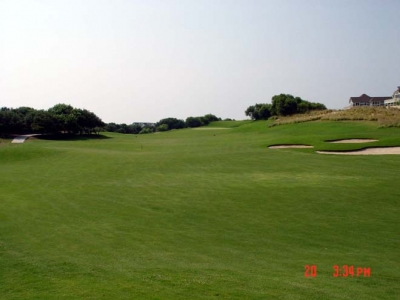 |
| It's a long way to the green on the 12th hole. |
According to Craig Menne, the par-3 eleventh is architect Jones's favorite hole on the course. Playing 190 yards from the back tees, it features a large green protected on the right front by what must be the largest bunker on the entire course. If you don't trust your swing enough to fly the ball to the green, a knockdown shot that scampers through the opening on the left side will see you safely to the putting surface, which offers a view of the ocean across Highway 12.
The scorecard lists hole number 12 as the toughest hole on the course and Menne agrees. "With the prevailing wind out of the southwest, the tee shot is very demanding. You have to avoid three bunkers on the right and then your second shot is straight up the hill all the way."
This 454-yard, par-4 skirts the edge of a large sandy ridge extending all the way from tee to green on this dogleg right hole. Originally, it featured one long bunker, about 75-100 yards long, at the bend, but Jones came back to soften the hole slightly by replacing that monster with three smaller ogres.
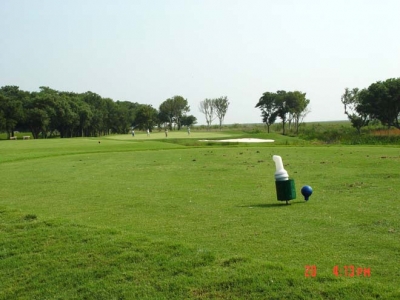 |
| The par three 15th hole, next to Currituck Sound. |
Take a good look around on the next tee. From this vantage point, you can see the ocean to the east, the Currituck Beach Lighthouse in Corolla to the north and the shallow waters of Currituck Sound to the west. And don't forget, you have a par-5 to play here.
Following a short, but saucy risk-reward par-4, you return to the shore of the Currituck Sound. From here to the home hole, the marsh grass-edged sound and the usual southwest wind await to wreak havoc on your score.
The fifteenth is a lovely little par-3, often nominated as The Currituck Club's signature hole. Just 174 yards from the back tees, it's not overly long, but a small pond intrudes between tee and green. Players spending too much time contemplating the wet stuff can find themselves in it all too easily.
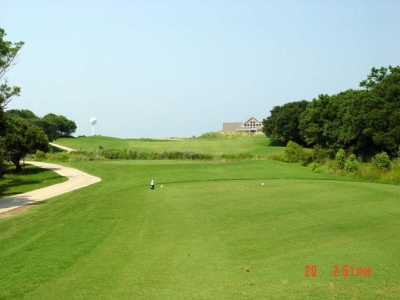 |
| Short but uphill all the way on the 9th hole. |
The trio of closing holes, a par-5 and two par-4s, present good birdie opportunities -- as long as you avoid the sound on the right and the woods or back yards of the homes on the left. If you can control the shape of your shots and stick your approach shots close, your round will feature a happy ending.
Back at the 12,000-square foot clubhouse, you can freshen up in the well-appointed locker room and then relax over a refreshing adult beverage in the grill while you tote up your score. The Currituck Club's members have a private lounge upstairs.
Property owners at The Currituck Club can become members by paying an initiation fee and monthly dues. Privileges include playing golf for cart fees only and having priority in making tee times from June-August. Rental guests of members enjoy reduced green fees and priority tee times. The course does welcome outside play, with tee times available 14 days in advance.
The Currituck Club is affiliated with Club Corp and is a founding member of the Outer Banks Golf Association. Golf packages with overnight accommodations can be arranged by calling 800-916-6244. Information is available at www.outerbanksgolf.com.
Details:
The Currituck Club
1 Currituck Clubhouse Drive
Corolla, NC 27927
Phone: (242) 453-9400
Toll Free: (800) 453-9400
Website: www.thecurrituckgolfclub.com
Course Architect: Rees Jones
Director of Golf: Craig Menne
Head Golf Professional: Eric Depoy
Superintendent: Wayne May
| Tees | Yardage/Slope | Rating |
| Black | 6885/136 | 74.0 |
| Blue | 6404/128 | 71.6 |
| White | 5814/121 | 68.9 |
| Red | 4776/120 | 68.5 |
Rates:
Rates vary according to season, ranging from $45 in winter to $150 in the summer season, which runs from June 29th to August 16th. Twilight and Junior rates are also available. All rates include green fee cart and taxes, and are subject to change without notice. Consult the website for more information.
| Related Links | Comments on this article? | |
|
Maryland National Golf Club Hollow Creek Golf Club Rocky Gap Resort PB Dye Golf Club in Ijamsville Whiskey Creek Golf Club |
E-mail Jeff Rendall, Editor: jrendall@golftheunitedstates.com |











